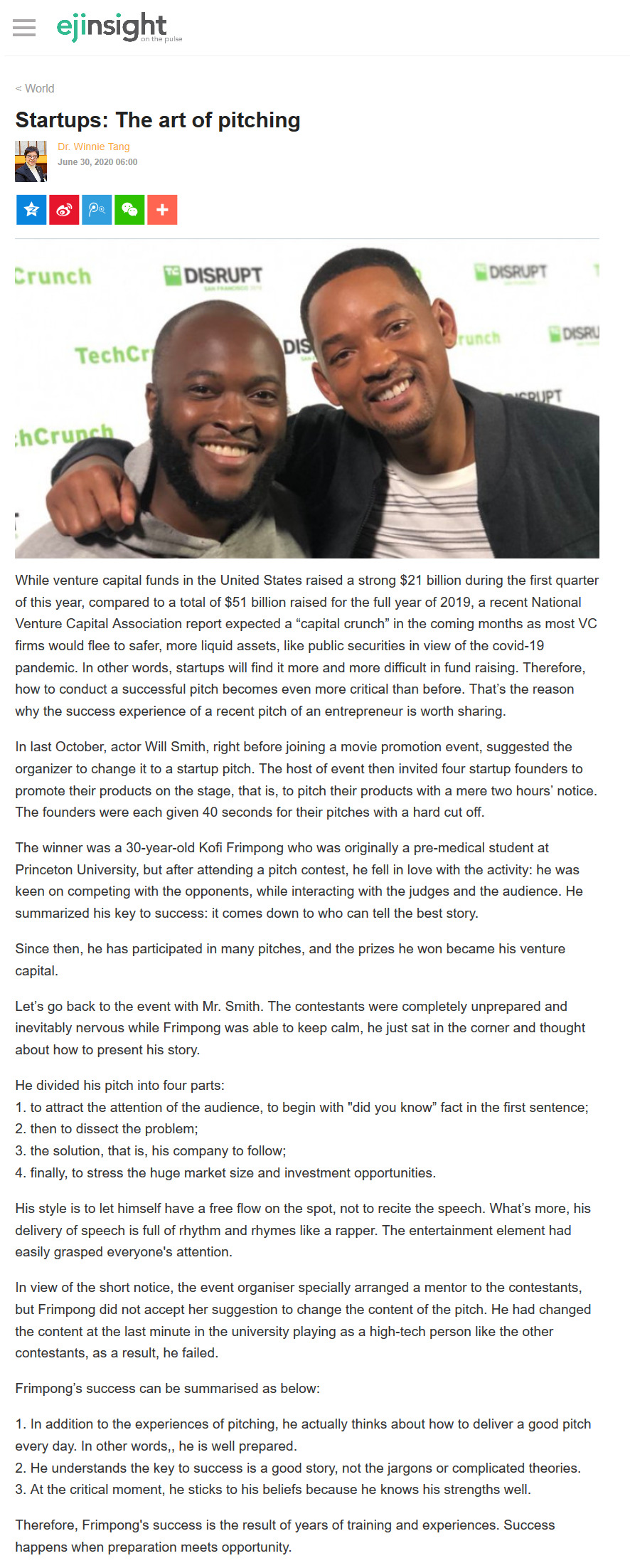網上版請按此

Startups: The art of pitching
While venture capital funds in the United States raised a strong $21 billion during the first quarter of this year, compared to a total of $51 billion raised for the full year of 2019, a recent National Venture Capital Association report expected a "capital crunch" in the coming months as most VC firms would flee to safer, more liquid assets, like public securities in view of the covid-19 pandemic. In other words, startups will find it more and more difficult in fund raising. Therefore, how to conduct a successful pitch becomes even more critical than before. That's the reason why the success experience of a recent pitch of an entrepreneur is worth sharing.
In last October, actor Will Smith, right before joining a movie promotion event, suggested the organizer to change it to a startup pitch. The host of event then invited four startup founders to promote their products on the stage, that is, to pitch their products with a mere two hours' notice. The founders were each given 40 seconds for their pitches with a hard cut off.
The winner was a 30-year-old Kofi Frimpong who was originally a pre-medical student at Princeton University, but after attending a pitch contest, he fell in love with the activity: he was keen on competing with the opponents, while interacting with the judges and the audience. He summarized his key to success: it comes down to who can tell the best story.
Since then, he has participated in many pitches, and the prizes he won became his venture capital.
Let's go back to the event with Mr. Smith. The contestants were completely unprepared and inevitably nervous while Frimpong was able to keep calm, he just sat in the corner and thought about how to present his story.
He divided his pitch into four parts:
1. to attract the attention of the audience, to begin with "did you know" fact in the first sentence;
2. then to dissect the problem;
3. the solution, that is, his company to follow;
4. finally, to stress the huge market size and investment opportunities.
His style is to let himself have a free flow on the spot, not to recite the speech. What's more, his delivery of speech is full of rhythm and rhymes like a rapper. The entertainment element had easily grasped everyone's attention.
In view of the short notice, the event organiser specially arranged a mentor to the contestants, but Frimpong did not accept her suggestion to change the content of the pitch. He had changed the content at the last minute in the university playing as a high-tech person like the other contestants, as a result, he failed.
Frimpong's success can be summarised as below:
1. In addition to the experiences of pitching, he actually thinks about how to deliver a good pitch every day. In other words, he is well prepared.
2. He understands the key to success is a good story, not the jargons or complicated theories.
3. At the critical moment, he sticks to his beliefs because he knows his strengths well.
Therefore, Frimpong's success is the result of years of training and experiences. Success happens when preparation meets opportunity.
Dr. Winnie Tang
Adjunct Professor, Department of Computer Science, Faculty of Engineering; Department of Geography, Faculty of Social Sciences and Faculty of Architecture, The University of Hong Kong